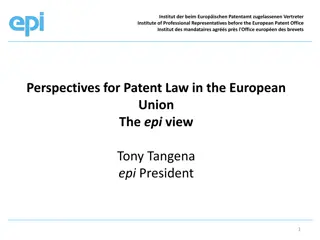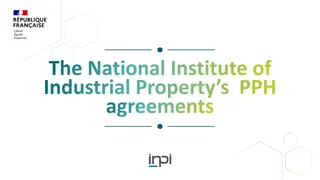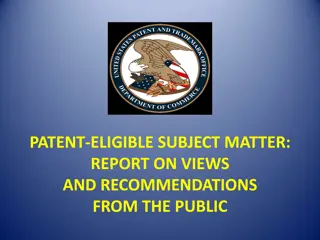
How Long Does It Take to Get a Utility Patent? | Patent Timeline Explained
Learn how long it takes to get a utility patent and protect your invention. This guide explains the patent application process, average timelines, and factors that can impact approval. Discover tips for reducing delays, including best practices for f
- patent
- utility patent
- utility drawings
- utility illustrations
- utility patent drawings
- patent application
- patent drafting
- uspto
- patent drawings services
- design patent
- illustrations
- caddrawings
- CAD
- technology
- services
- business
- startups
Download Presentation

Please find below an Image/Link to download the presentation.
The content on the website is provided AS IS for your information and personal use only. It may not be sold, licensed, or shared on other websites without obtaining consent from the author. Download presentation by click this link. If you encounter any issues during the download, it is possible that the publisher has removed the file from their server.
E N D
Presentation Transcript
How Long Does It Take to Get a Utility Patent? Patent Timeline Explained The Patent Experts Introduction Securing a utility patent is an essential step for protecting inventions and intellectual property. Understanding how long the process takes can help inventors plan effectively. In this guide, we ll break down the steps involved, average timelines, and tips for expediting the process. Utility patents provide inventors with the right to exclude others from making, using, or selling their invention without permission. Knowing the timeline is key to managing expectations and aligning resources for your project. Whether you're an independent inventor or part of a larger organization, this information is valuable. What Is a Utility Patent? A utility patent grants exclusive rights to inventors for new and useful inventions. These can include machines, processes, compositions of matter, or improvements to existing technologies. Utility patents are the most common type of patent in the United States. They provide protection for up to 20 years from the filing date, offering inventors legal recourse against unauthorized use.
To qualify, the invention must be novel, non-obvious, and useful. Novelty means the invention is unique and hasn t been disclosed publicly before the filing date. Non-obviousness indicates that the invention isn t an obvious improvement over existing solutions. Usefulness ensures that the invention has a clear and beneficial purpose. Utility patents differ from design patents, which protect ornamental designs, and plant patents, which cover new plant varieties. Understanding these distinctions is crucial before starting the application process. Steps in the Utility Patent Process Filing the Application The first step is preparing and submitting your patent application to the United States Patent and Trademark Office (USPTO). This involves drafting detailed descriptions, claims, and drawings of your invention.
Claims define the scope of your invention, while drawings visually illustrate its functionality or structure. Working with professionals, such as patent attorneys or specialized drafting services, can help ensure accuracy. Any mistakes in your application could lead to delays or even rejections. Additionally, inventors may need to file a provisional application to secure an earlier filing date before submitting the full utility patent application. Examination Process Once submitted, the USPTO assigns an examiner to review your application. This stage includes evaluating the invention s novelty, non-obviousness, and usefulness. The examiner conducts a prior art search to ensure the invention hasn t been disclosed in existing patents or publications. Examiners may issue office actions, which are formal documents highlighting issues or requiring clarification. Responding to these office actions promptly and comprehensively is essential to keep the process moving. The back-and-forth communication can take several months or even years, depending on the complexity of the invention. Final Approval After addressing any concerns, the USPTO will either grant or reject your application. If granted, you ll receive a utility patent that offers protection and enforcement rights. Rejections aren t the end of the road; inventors can appeal or make amendments to overcome objections. Final approval is a significant milestone, marking the beginning of your patent s enforceable life span. It allows inventors to license their
inventions, take legal action against infringers, and monetize their intellectual property. How Long Does the Process Typically Take? The utility patent process can take anywhere from 12 to 36 months. On average, it takes about 22 months from filing to final approval. This timeline can vary depending on the type of invention and the workload at the USPTO. Some industries, such as biotechnology or software, may experience longer timelines due to complex evaluations. Simpler inventions with well-prepared applications may move through the process more quickly. Expedited options, such as the USPTO s Track One Prioritized Examination, can reduce the timeline to as little as 12 months. However, these options often involve additional fees. Factors such as the complexity of the invention, backlog at the USPTO, and the completeness of the application all play a role. By understanding these timelines, inventors can better prepare for the journey ahead. Factors That Can Impact the Timeline Quality of the Application A well-prepared application can significantly reduce processing time. Errors, vague descriptions, or incomplete documentation often lead to delays. Spending time upfront to ensure accuracy can save you months or even years later. Backlogs at the USPTO
The USPTOs workload fluctuates based on the number of applications submitted annually. High demand for patents can create bottlenecks, increasing wait times for examinations. Inventors should monitor USPTO updates to understand current backlogs. Responses to Office Actions Timely and thorough responses to USPTO queries can accelerate the process. Delays in addressing these requests can extend the timeline and potentially result in abandonment of the application. Engaging a patent attorney can help ensure responses meet USPTO standards. Tips for Reducing Your Patent Approval Time Best Practices for Filing Double-check all documentation before submission. Using professional templates and ensuring compliance with USPTO guidelines can save time. Be proactive in addressing potential issues by consulting patent resources or experts. Including high-quality drawings is another best practice that helps examiners understand your invention. For professional assistance with patent drawings, visit The Patent Experts. Hiring a Patent Attorney An experienced attorney can streamline the process. They help with drafting, filing, and responding to office actions efficiently. While hiring an attorney involves additional costs, their expertise can save you time and improve your chances of approval. Conclusion
Getting a utility patent takes time, but understanding the process can make it more manageable. With careful planning and attention to detail, inventors can protect their ideas effectively. By following the steps and tips shared here, you can minimize delays and improve your chances of success. For professional assistance with utility patent drawings, visit The Patent Experts to ensure your application is complete and accurate. Take the first step today toward safeguarding your innovation and securing your intellectual property rights.






















